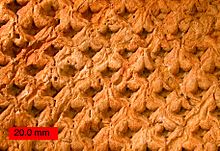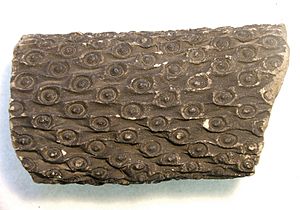Lepidodendron facts for kids
Quick facts for kids LepidodendronTemporal range: Carboniferous
|
|
|---|---|
 |
|
| External mold of Lepidodendron from the Pennsylvanian of Ohio. | |
| Scientific classification | |
| Kingdom: | |
| Division: | |
| Class: | |
| Order: |
Lepidodendrales
|
| Family: |
Lepidodendraceae
|
| Genus: |
Lepidodendron
|
Lepidodendron was a type of ancient, tree-like plant that is now extinct. These plants were among the first very large trees to grow on land. They formed a big part of the coal forests in tropical areas.
These trees were huge! They could grow over 30 meters (100 feet) tall. Their trunks were often more than 1 meter (3 feet) wide. People sometimes call them 'giant club mosses'. But they are actually more closely related to plants called quillworts than to modern clubmosses.
Contents
Ancient Habitats of Lepidodendron
Lepidodendron trees grew very well during a time called the Pennsylvanian period. This was about 315 to 300 million years ago. They lived in tropical swamps and rain forests. These areas were part of a huge river system. This ancient river system was much larger than the Amazon basin today.
The flat land of this river system stretched across a supercontinent called Pangaea. It was about 5,000 kilometers (3,100 miles) long. This huge wetland went from eastern Canada all the way to the Ukraine. It was also about 700 kilometers (435 miles) wide. This means the Pennsylvanian basin was bigger than any wetlands on Earth today.
Climate Changes and Their Impact
The large rainforest system began to disappear about halfway through the Pennsylvanian period. The climate became cooler and drier. The wetland forests ended when the land level was pushed up. This happened because the Gondwana continent pressed against another continent called Laurussia.
The end of these coal-forming forests marks the end of the Carboniferous period. However, in China, the wetland forests continued to grow for another 50 million years. This was because China was too far away to be affected by the land changes.
How Lepidodendron Looked

Lepidodendron had tall, thick trunks that usually did not branch out much. At the top, they had a crown of branches that split into two. These branches held many leaves. The leaves were long and thin, like large blades of grass. They grew in a spiral pattern around the branches.
As the plant grew, its old leaves fell off. This left diamond-shaped marks on the trunk and stems. These marks were packed closely together. They are some of the most common and interesting fossils found in Carboniferous shale and coal deposits. These fossils often look like tire tracks or alligator skin.
These marks, called leaf cushions, were made of green tissue that could perform photosynthesis. This means they could make food from sunlight. Tiny pores called stomata covered them. These pores allowed carbon dioxide from the air to enter the plant. This also means the trunks of Lepidodendron were green. Modern trees usually have brown or gray bark that does not photosynthesize.
Lepidodendron was like a giant herb. Its trunks had very little wood inside. Most of the support came from a thick, bark-like outer layer. This layer stayed firm around the trunk and did not flake off like bark on most modern trees. As the tree grew wider, the leaf cushions also expanded to fit the growing trunk.
The branches of this plant ended in cone-like structures. Lepidodendron did not produce seeds like many modern plants. Instead, it reproduced by making spores.
Stigmaria: The Roots of Ancient Trees

Stigmaria are a type of branching tree root fossil found in Carboniferous rocks. These were the roots of ancient coal forest trees like Sigillaria and Lepidodendron. Each tree trunk had four of these large roots. Stigmaria is a "form taxon." This means we cannot always tell the exact genus and species of the plant that grew the root just from the Stigmaria fossil itself.
Images for kids
See also
 In Spanish: Lepidodendron para niños
In Spanish: Lepidodendron para niños



